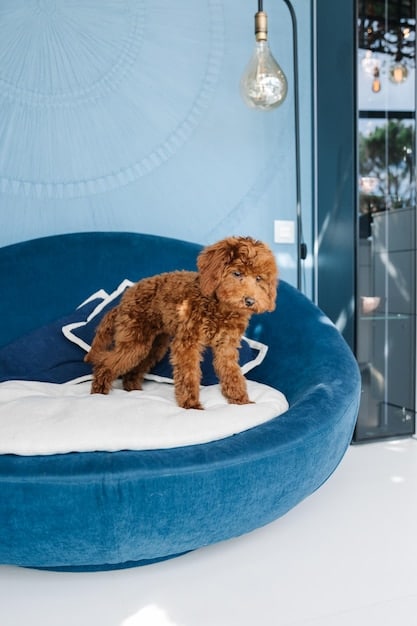Latest Trends in Animal Shelter Design: Creating Stress-Free Pet Havens

The latest trends in animal shelter design prioritize creating stress-free environments for pets by focusing on reducing noise, providing comfortable and enriching spaces, and implementing innovative cleaning and disease prevention protocols, ultimately improving animal welfare and adoption rates.
Discover the latest trends in animal shelter design: creating a stress-free environment for pets is now paramount. Shelters are moving beyond basic housing to become havens that promote animal well-being and successful adoptions. How are these changes being implemented?
Innovative Layouts for Reduced Stress
Animal shelters are increasingly adopting innovative layouts designed to minimize stress and promote a sense of calm for the animals. This involves rethinking traditional kennel arrangements and incorporating features that cater to the specific needs of different species and individual animals.
De-institutionalizing the Environment
One major trend is the move away from sterile, institutional-looking environments towards more home-like settings. This aims to reduce the anxiety and fear that animals often experience in traditional shelter layouts.
Creating Separate Zones
Shelters are now creating distinct zones for different activities and needs. Quiet zones for resting, enriching play areas for exercise, and specialized medical areas for treatment are becoming standard.
- Noise Reduction Strategies: Implementing soundproofing materials and design features to minimize noise levels, thereby reducing stress.
- Visual Barriers: Using partial walls or visual screens to create privacy and reduce reactivity between animals.
- Natural Light: Incorporating large windows and skylights to maximize natural light, which has been shown to have a positive impact on animal behavior and mood.
- Ventilation Systems: Upgrading ventilation systems to improve air quality and reduce the spread of airborne illnesses.
By implementing these design strategies, shelters can create environments that are less overwhelming and more conducive to the well-being of their residents.
Optimizing Comfort and Enrichment
Beyond the basic layout, animal shelters are focusing on optimizing comfort and enrichment to improve the quality of life for their residents. This includes providing comfortable bedding, stimulating toys, and opportunities for social interaction.

Personalized Spaces
Providing animals with a sense of ownership over their space is crucial. Shelters are offering personalized bedding, toys, and enrichment items tailored to each animal’s individual preferences.
Interactive Play Areas
Creating interactive play areas that allow animals to engage in natural behaviors is also gaining popularity. These areas may include climbing structures for cats, digging pits for dogs, and puzzle feeders for all types of animals.
- Comfortable Bedding: Providing soft, clean bedding that is appropriate for each animal’s size and needs.
- Variety of Toys: Offering a variety of toys that stimulate different senses and encourage natural behaviors.
- Socialization Opportunities: Facilitating safe and supervised social interaction between compatible animals.
- Human Interaction: Encouraging volunteers and staff to spend time interacting with the animals, providing companionship and affection.
These enhancements can significantly reduce stress, boredom, and behavioral problems in shelter animals, making them more adoptable.
Advanced Cleaning and Disease Prevention
Maintaining a clean and sanitary environment is essential for preventing the spread of disease in animal shelters. Modern shelters are implementing advanced cleaning and disease prevention protocols to protect the health and well-being of their residents.
Durable and Easy-to-Clean Materials
Using durable and easy-to-clean materials for flooring, walls, and surfaces is crucial. This helps to prevent the build-up of bacteria and viruses, reducing the risk of infection.
Advanced Ventilation Systems
Upgrading ventilation systems to improve air quality and reduce the spread of airborne illnesses is also a key trend. This can involve installing HEPA filters and implementing regular air exchange protocols.
- Centralized Cleaning Systems: Implementing centralized cleaning systems that deliver disinfectants and sanitizers to all areas of the shelter.
- UV Sterilization: Using UV sterilization to kill bacteria and viruses on surfaces and in the air.
- Quarantine Protocols: Establishing strict quarantine protocols for new arrivals and animals showing signs of illness.
- Regular Health Checks: Conducting regular health checks and vaccinations to prevent the spread of disease.
By prioritizing cleanliness and disease prevention, shelters can create healthier environments for their animals, reducing the need for medical treatment and improving their overall well-being.
The Role of Color and Design Psychology
The colors and design elements used in an animal shelter can have a significant impact on the animals’ mental and emotional states. Modern shelters are leveraging color and design psychology to create calming and soothing environments.
Calming Color Palettes
Using calming color palettes, such as blues, greens, and soft neutrals, can help to reduce anxiety and stress in animals. These colors are known to have a soothing effect on the nervous system.
Nature-Inspired Design Elements
Incorporating nature-inspired design elements, such as natural textures, patterns, and imagery, can also promote a sense of calm and well-being. This can involve using wood accents, stone features, and landscape paintings.

- Acoustic Design: Implementing acoustic design elements to minimize noise and echo, such as sound-absorbing panels and textured surfaces.
- Visual Stimulation: Providing visual stimulation through windows, murals, and interactive displays.
- Scent Enrichment: Using scent enrichment to create a more stimulating and engaging environment, such as diffusing calming essential oils.
- Ergonomic Design: Designing spaces that are ergonomic for both animals and staff, promoting comfort and efficiency.
By paying attention to color and design psychology, shelters can create environments that are not only visually appealing but also emotionally supportive for their residents.
Enhancing Adoption Rates Through Design
A well-designed animal shelter can also play a significant role in enhancing adoption rates. By creating a welcoming and comfortable environment, shelters can attract more potential adopters and make a positive first impression.
Creating a Welcoming Atmosphere
Designing a welcoming and comfortable atmosphere for visitors is essential. This can involve creating comfortable seating areas, providing refreshments, and displaying information about the animals in an engaging and accessible way.
Showcasing the Animals
Showcasing the animals in a way that highlights their individual personalities and qualities is also crucial. This can involve creating attractive kennel displays, providing opportunities for interaction, and sharing adoption success stories.
- Open and Transparent Design: Implementing an open and transparent design that allows visitors to easily see and interact with the animals.
- Interactive Adoption Areas: Creating interactive adoption areas where potential adopters can spend time getting to know the animals.
- Adoption Counseling: Providing adoption counseling to help potential adopters find the right animal for their lifestyle and needs.
- Post-Adoption Support: Offering post-adoption support to help adopters successfully integrate their new pets into their homes.
By prioritizing the adoption experience, shelters can increase their adoption rates and find loving homes for more animals.
The Impact of Social Media on Shelter Design
Social media has significantly impacted animal shelter design, as shelters now need to consider how their facilities will look in photos and videos shared online. This has led to a greater emphasis on aesthetics and visual appeal.
Creating Instagrammable Spaces
Shelters are now creating “Instagrammable” spaces that are visually appealing and shareable on social media. This can involve using colorful murals, creative backdrops, and attractive signage.
Sharing Success Stories
Sharing adoption success stories and behind-the-scenes glimpses of shelter life on social media can also help to attract more followers and potential adopters. This can involve posting photos and videos of happy animals, showcasing the work of volunteers and staff, and promoting upcoming events.
- Professional Photography: Investing in professional photography to capture high-quality images of the animals and the shelter.
- Virtual Tours: Creating virtual tours of the shelter to showcase its design and facilities.
- Social Media Campaigns: Launching social media campaigns to promote adoption and raise awareness about the shelter’s mission.
- Online Fundraising: Using social media to raise funds for shelter improvements and animal care.
By leveraging the power of social media, shelters can reach a wider audience and increase their visibility, ultimately helping them to save more animals.
| Key Point | Brief Description |
|---|---|
| 🏡 Home-Like Environments | Moving away from sterile settings to more comfortable, home-like layouts. |
| 🎨 Color Psychology | Using calming colors like blues and greens to reduce animal stress. |
| 🧼 Hygiene Protocols | Implementing advanced cleaning and ventilation for disease prevention. |
| 📸 Social Media Appeal | Designing spaces that are visually appealing for online sharing. |
[Frequently Asked Questions]
▼
Stress reduction is crucial because it directly impacts the physical and mental health of shelter animals. Low stress is associated with better immune functions and reduces behavioral problems, increasing the likelihood of successful adoptions.
▼
Personalized spaces give animals a sense of control and ownership, which can significantly reduce anxiety. Bedding, toys, and enrichment items tailored to individual preferences help animals feel more secure and comfortable.
▼
Color can greatly influence an animal’s mental state. Calming colors, like blues and greens, can reduce anxiety and stress, while nature-inspired design elements promote a sense of well-being, creating a more emotionally supportive environment.
▼
Advanced cleaning protocols are essential for preventing the spread of disease. Durable, easy-to-clean materials and upgraded ventilation systems help maintain a sanitary environment, protecting the health and well-being of shelter residents.
▼
A well-designed shelter creates a welcoming atmosphere that attracts potential adopters. Open layouts, interactive areas, and attractive displays highlight animals’ personalities, increasing the chances of finding them loving homes through enhanced adoption rates.
Conclusion
As animal shelters evolve, prioritizing stress-free environments through innovative design is becoming increasingly vital. By focusing on comfort, hygiene, and emotional well-being, shelters can improve the lives of their residents and increase adoption rates, making a significant difference in animal welfare.





